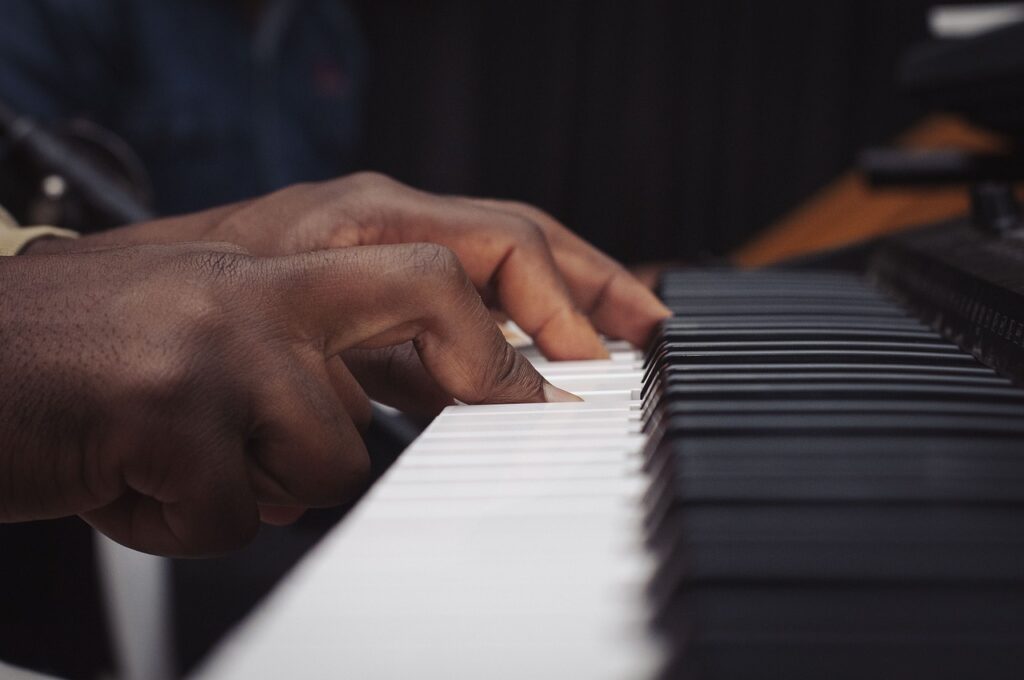The Lydian mode is a unique and uplifting musical scale that blends the familiarity of the major scale with a distinctive twist, an augmented fourth. Its dreamy quality has made it a favorite in cinematic scores, jazz and progressive rock, where its bright, ethereal sound elevates compositions to new emotional heights.
What is the Lydian mode? In this article, we’ll dive into the essence of the Lydian mode, explore its scales and keys and provide practical steps for incorporating it into your piano playing.
- Fall in love with the music - Learn your favorite songs, at a level suitable for you.
- Enjoy interactive piano lessons - Explore courses covering music theory, technique chords & more.
- Get real-time feedback - Skoove's feedback tells you what went well and what needs practice.

What is Lydian mode?
The Lydian mode is one of seven musical modes found in a major scale, the fourth mode of the diatonic scale. It is known for its bright and uplifting sound, similar to the major scale but distinguished by its augmented fourth (raised fourth degree). This sharp four gives the Lydian mode its dreamy and otherworldly quality. Even in minor keys, the Lydian mode can shift the mood to something hopeful or magical, depending on how it’s used.
With roots in ancient Greek music where modes were tied to emotions and storytelling, the Lydian mode has found a place in modern music across genres like classical, pop and film. Let’s take a look at how this scale is built.
In the C Lydian mode, the fourth note—F—is raised to F♯. The interval pattern of the Lydian mode is as follows:
W-W-W-H-W-W-H
(W = Whole Step, H = Half Step)
This sequence of intervals creates the sound that gives the mode its character; it can be thought of as the Lydian mode formula.
Here’s how the C Lydian scale looks:
C – D – E – F♯ – G – A – B – C

The augmented fourth (F♯ in this case) is the defining characteristic of the Lydian mode. This interval creates tension and resolution, lending the mode its uplifting, floaty quality.
Compare this to the Ionin mode to really feel the unique quality of the Lydian mode:
C – D – E – F – G – A – B – C
Lydian mode scales
The Lydian mode, like all modes, can be played in any key. Its interval pattern remains consistent, making it instantly recognizable regardless of the starting note. To grasp the Lydian mode fully, let’s explore its structure and how it transforms across different keys.
Below is a comprehensive table showing the Lydian modes across all 12 keys:
| Mode | Notes |
|---|---|
| C | C – D – E – F♯ – G – A – B – C |
| C♯/D♭ | C♯ – D♯ – E♯ – F♯♯ – G♯ – A♯ – B♯ – C♯ |
| D | D – E – F♯ – G♯ – A – B – C♯ – D |
| E♭ | E♭ – F – G – A – B♭ – C – D – E♭ |
| E | E – F♯ – G♯ – A♯ – B – C♯ – D♯ – E |
| F | F – G – A – B – C – D – E – F |
| F♯/G♭ | F♯ – G♯ – A♯ – B♯ – C♯ – D♯ – E♯ – F♯ |
| G | G – A – B – C♯ – D – E – F♯ – G |
| G♯/A♭ | G♯ – A♯ – B♯ – C♯♯ – D♯ – E♯ – F♯♯ – G♯ |
| A | A – B – C♯ – D♯ – E – F♯ – G♯ – A |
| A♯/B♭ | A♯ – B♯ – C♯♯ – D♯ – E♯ – F♯♯ – G♯♯ – A♯ |
| B | B – C♯ – D♯ – E♯ – F♯ – G♯ – A♯ – B |
Learning how the Lydian mode applies to different keys expands your tonal palette, allowing you to compose or improvise in a variety of contexts.
The Lydian mode and scale degrees
Diatonic modes of the major scale, such as Lydian, can be formed by playing a major scale from a specific degree. The Lydian mode is formed by playing from the fourth degree. Let’s break this down:
1. Start with a major scale: For example, in C major (C Ionian), the notes are: C, D, E, F, G, A, B, C.
2. Begin on the fourth note: Start on F instead of C.
3. Play the same sequence of notes as the major scale starting on the fourth degree: In this case, F, G, A, B, C, D, E, F.
Now you have constructed the F Lydian mode from the second fourth of a major scale. Well done! This process works for any key. Try forming more examples of the Lydian scale and compare them to the table we just reviewed.
How to play the Lydian mode on piano?
As with any of the piano scales you may have practiced, mastering the Lydian mode on the piano unlocks a world of creative potential. Its distinctive major feel with a raised fourth gives it a bright, otherworldly sound, making it ideal for crafting uplifting melodies and imaginative improvisations.
Start with F Lydian:
- Place your right-hand thumb (finger 1) on F.
- Use this finger pattern: 1 (F), 2 (G), 3 (A), thumb under to 1 (B), 2 (C), 3 (D), 4 (E), 5 (F).
- Descend back using the same fingering.
Add the left hand:
- Begin with your pinky (finger 5) on F.
- Follow the pattern: 5 (F), 4 (G), 3 (A), 2 (B), thumb (1) for C, cross over with 3 (D), 2 (E), 1 (F).
- Practice ascending and descending until the motion feels smooth.
Move to other keys:
- Once you’ve mastered F Lydian, try C Lydian (C, D, E, F#, G, A, B, C) or G Lydian (G, A, B, C#, D, E, F#, G).
Practice with variations:
- Rhythm: Add syncopation or triplets to make your practice more engaging.
- Dynamics: Play softly (piano) or loudly (forte) to explore expressive contrasts.
- Improvisation: Use the Lydian mode to create melodies or riffs.
Learning the Lydian mode can feel overwhelming, especially when exploring all its scales and keys. That’s where Skoove comes in. With interactive piano lessons and real-time feedback, whether you’re mastering scales or learning how to play piano for beginners, Skoove provides a helping hand on your piano journey.
Top 3 songs to play with Lydian mode
Here are three great songs you can learn with Skoove to dive into the unique character of Lydian music while improving your piano skills!
Imagine – John Lennon
This timeless anthem gains a subtle sense of wonder and uplift, with the addition of a raised fourth thorough improvisation and embellishment.
Bye Bye Blackbird – Eddie Cantor
This classic tune feels light and whimsical; the rich chord progressions lend themselves well to a Lydian inflection adding a playful and airy quality to its nostalgic charm.
Blue Moon – Rodgers & Hart
This timeless melody exudes a dreamy and uplifting quality. Incorporating Lydian tones enhances its ethereal feel, giving the song an enchanting and wistful charm.
Conclusion
The Lydian mode’s uplifting, ethereal quality makes it a go-to for musicians seeking a bright and expressive sound. Its unique augmented fourth adds emotional depth, making it a staple in everything from classical compositions to modern film scores.
Mastering the Lydian mode on piano enhances both your technical skills and creative expression. With practice and tools like Skoove, you can bring its captivating tones to life and explore its full potential. So, sit at your piano, embrace the Lydian mode and let it inspire your next masterpiece. Happy practicing!
Author of this blog post:
Susana Pérez Posada

With over seven years of piano education and a deep passion for music therapy, Susana brings a unique blend of expertise to Skoove. A graduate in Music Therapy from SRH Hochschule Heidelberg and an experienced classical pianist from Universidad EAFIT, she infuses her teaching with a holistic approach that transcends traditional piano lessons. Susana’s writings for Skoove combine her rich musical knowledge with engaging storytelling, enriching the learning experience for pianists of all levels. Away from the piano, she loves exploring new places and immersing herself in a good book, believing these diverse experiences enhance her creative teaching style.
Published by Lydia Ogn from the Skoove team















